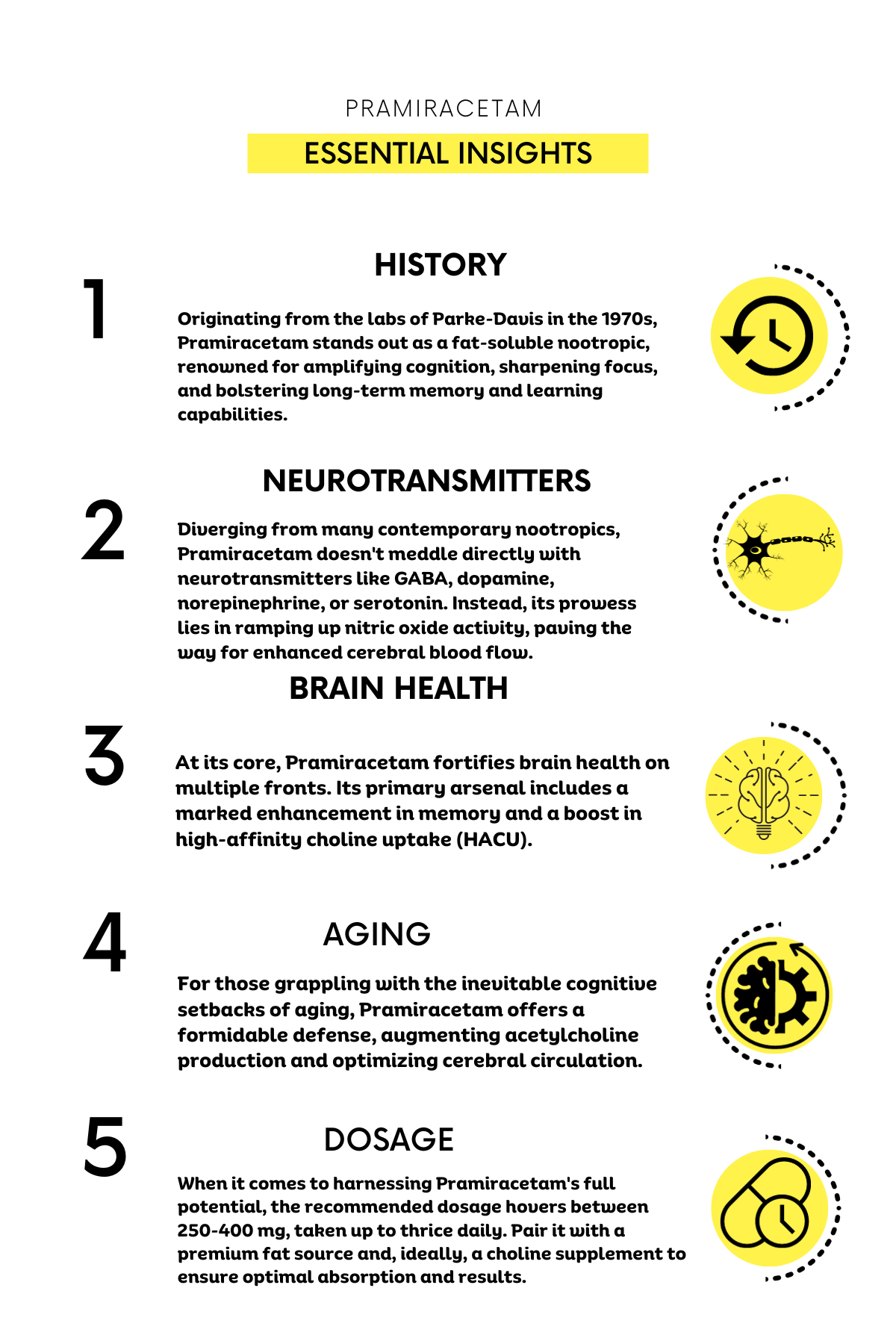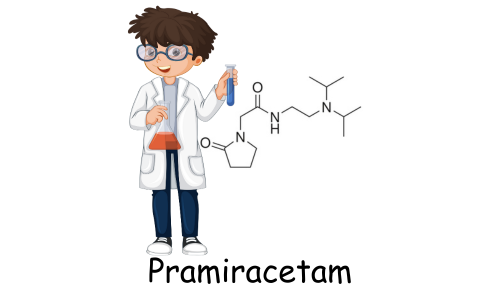
In today’s competitive academic and corporate landscapes, there’s a lesser-known tool that top students and seasoned executives have been quietly leveraging: Pramiracetam. Beyond the usual grind and traditional nootropic dietary supplements, this cognitive enhancer has significantly contributed to enhanced brain function and mental performance. While the world buzzes about various smart drugs, Pramiracetam offers a distinct, scientifically backed edge. For those seeking to understand the nuances of cognitive enhancement and the mechanisms that drive peak mental performance, a deep dive into Pramiracetam’s workings and benefits is essential. Let’s explore the facts.

- What is Pramiracetam?
- The History of Pramiracetam: From Inception to Modern-Day Relevance
- Pramiracetam’s Unique Mechanism: A Deep Dive into Brain Chemistry
- Neurotransmitters and Racetams
- Pramiracetam’s Distinct Pathway
- The Acetylcholine Connection
- Why is Acetylcholine So Important?
- How Does Pramiracetam Make You Feel?
- The Benefits of Pramiracetam
- Enhanced Acetylcholine Synthesis and Utilization
- Improved Cerebral Circulation
- Increased Focus and Learning Ability
- Boosted Neuroplasticity and Memory Recall
- Pramiracetam Randomized Controlled Trials
- Pramiracetam’s Impact on Memory
- Pramiracetam’s Boost to Cognitive Function
- Pramiracetam and Brain Wave Normalization
- Optimal Nootropic Stacks with Pramiracetam
- 1. Fatty Acids: MCT Oil & Fish Oil
- 2. Choline Sources: Alpha GPC & Citicoline
- 3. Racetams: Aniracetam, Oxiracetam & Phenylpiracetam
- 4. Natural Nootropics: Bacopa Monnieri, Ginkgo Biloba & Panax Ginseng
- Pramiracetam Dosage: Finding the Right Amount
- Pramiracetam Side Effects
- In Conclusion: Pramiracetam’s Unique Cognitive Edge
- FAQ’s
What is Pramiracetam?

Pramiracetam, often recognized by its alternative names such as CI-879, Pramistar, Neupramir, and Remen, stands as a prominent figure in the world of nootropics. For those unfamiliar with the term “nootropics,” think of them as “brain boosters” – supplements or drugs designed to enhance cognitive function, improve memory,, and mental clarity.
Now, within this vast realm of nootropics, there’s a specific class known as “racetams.” Pramiracetam belongs to this elite class, setting itself apart with its unique properties. Unlike some of its counterparts, Pramiracetam doesn’t play directly with neurotransmitters like GABA or dopamine. Instead, its prowess lies in amplifying nitric oxide activity, which in layman’s terms, means it boosts blood flow to the brain, enhancing its efficiency.
In essence, when you hear “Pramiracetam,” think of it as a specialized tool in the cognitive enhancement toolbox designed for those seeking an edge in mental performance. As we delve deeper into its history and workings, you’ll gain a clearer understanding of why it’s revered by many in the academic and professional spheres.
The History of Pramiracetam: From Inception to Modern-Day Relevance
Diving into the annals of nootropic drugs history, Pramiracetam emerges as a significant figure. Conceived in the laboratories of Parke-Davis, a pharmaceutical titan of the 1970s, this potent compound was initially synthesized as an offshoot of its predecessor, Piracetam. The objective was clear: to create a nootropic with amplified potency. And the result? Pramiracetam was found to be up to 30 times more potent than the original Piracetam.
But what was the initial purpose of this compound? Interestingly, its first trials were conducted on Alzheimer’s disease patients. The results were mixed, prompting researchers to explore its potential in treating major depressive disorder. This journey of exploration led to Pramiracetam being licensed as an orphan drug to Menarini, who continued its research for dementia applications.
Fast forward to the 1990s, and the nootropic baton was passed to Cambridge Neuroscience Inc. Here, Pramiracetam was tested for its potential to restore cognitive function post-stroke or traumatic brain injury. Its efficacy in these areas further solidified its reputation in the nootropic community.
Today, Pramiracetam is not just a relic of pharmaceutical history. It’s actively prescribed in Europe for conditions like dyslexia, ADHD, and other memory-related challenges. Moreover, its brand names, including Pramistar, Neupramir, and Remen, are recognized by many. Beyond the medical realm, students, executives, and cognitive enthusiasts turn to Pramiracetam for its acclaimed benefits in enhancing cognition, focus, and memory.
Pramiracetam’s Unique Mechanism: A Deep Dive into Brain Chemistry
When we talk about nootropics, especially the racetam family, it’s easy to get lost in the sea of scientific jargon. But Pramiracetam stands out, not just for its potency but for its unique mechanism of action in the brain. Let’s break this down.
Neurotransmitters and Racetams
Most racetams, like Piracetam, have a direct influence on neurotransmitters such as acetylcholine, dopamine, and GABA. These neurotransmitters play pivotal roles in mood, memory, and overall cognitive function. However, Pramiracetam takes a different route.
Pramiracetam’s Distinct Pathway
Unlike its siblings, Pramiracetam doesn’t bind directly to these neurotransmitter receptors. Instead, it promotes vasodilation in the brain. This means it helps expand blood vessels, allowing for increased blood flow. One of the key players in this process is nitric oxide. By boosting nitric oxide activity, Pramiracetam ensures that more oxygen and nutrients reach the brain cells, enhancing overall brain health and function.
The Acetylcholine Connection
Now, let’s delve deeper into the world of acetylcholine.
What is Acetylcholine?
Acetylcholine is a neurotransmitter that plays a crucial role in memory formation, learning, and overall cognitive function. It’s the brain’s primary “learning” neurotransmitter and is vital for both the formation and retrieval of memories.Pramiracetam and Acetylcholine:
Pramiracetam’s relationship with acetylcholine is unique. It doesn’t bind to acetylcholine receptors directly. Instead, it enhances the high-affinity choline uptake (HACU). In simpler terms, it boosts the rate at which the brain uses choline to produce acetylcholine. This leads to an increase in acetylcholine synthesis, which can have profound effects on memory and learning.
Why is Acetylcholine So Important?
Memory and Learning: As mentioned, acetylcholine is central to these processes. An increase in its levels can lead to enhanced memory retention and faster learning.
Mood Regulation: Acetylcholine also plays a role in mood regulation, and its imbalance can lead to mood disorders.
Muscle Control: Beyond the brain, acetylcholine is essential for muscle contractions and general motor function.
How Does Pramiracetam Make You Feel?

Alright, let’s get down to the nitty-gritty. You’ve got the science, the history, and the mechanics of Pramiracetam. But what does it feel like when it hits your system? Let’s dive into the real-world effects based on both scientific findings and the shared experiences of those who’ve ventured into the world of Pramiracetam.
The Initial Kick: About 30 minutes to an hour after taking Pramiracetam, that’s when the magic starts. It’s not an overwhelming rush but a subtle shift. Imagine the sensation when the morning fog lifts, and everything suddenly appears sharper and clearer. That’s Pramiracetam for the brain.
Laser-Sharp Focus: Ever tried to read or work while there’s a TV blaring in the background? With Pramiracetam, it’s like someone hit the mute button on those distractions. You’re in the zone, locked in, and ready to tackle whatever task is at hand. This heightened focus can last anywhere from 4 to 6 hours, making those long study sessions or board meetings feel like a breeze.
Memory On Point: Remember that time you forgot… well, never mind. With Pramiracetam, those moments become fewer and farther between. Around 2 to 3 hours in, you might find yourself recalling names, dates, and details with an ease that feels almost uncanny.
Mental Stamina: You know that 3 PM slump? That moment when the coffee wears off, and all you want is a nap? Pramiracetam users often report that they can power through, feeling mentally charged and ready to conquer the second half of their day.
A Gentle Uplift: Pramiracetam isn’t a mood enhancer per se, but many users note a subtle mood boost. It’s not euphoria but more of a steady, positive outlook. Challenges seem less daunting, and there’s a sense of confidence in one’s cognitive abilities.
My Experience: I once took a 400mg dose of Pramiracetam alongside my morning coffee, complemented with some fish oil for the added fatty acids. Roughly 30 minutes in, I noticed a difference. It wasn’t just the usual kick from the caffeine; this was something more. A clear-headedness, a subtle boost in motivation, and a readiness to tackle the day’s tasks. It felt like a solid, no-nonsense cognitive enhancement that genuinely complemented my morning routine.
The Benefits of Pramiracetam
In the vast realm of nootropics, Pramiracetam stands out not just for its potency but for the tangible benefits it offers, many of which are backed by scientific studies. Let’s delve into the key advantages of incorporating Pramiracetam into your cognitive enhancement regimen.
Enhanced Acetylcholine Synthesis and Utilization
Pramiracetam plays a pivotal role in boosting the synthesis and utilization of acetylcholine (ACh) in the brain. Acetylcholine is a neurotransmitter essential for various cognitive functions, including memory and learning. By influencing the high-affinity choline uptake (HACU) system, Pramiracetam ensures that there’s an ample supply of ACh available for your neurons. This enhancement can lead to sharper cognition and improved memory recall.
Improved Cerebral Circulation
One of the standout features of Pramiracetam is its ability to increase cerebral circulation. Better blood flow to the brain means more oxygen and nutrients for your brain cells, leading to optimal brain function. This improved circulation can be particularly beneficial when tackling complex tasks or during intense study sessions.
Increased Focus and Learning Ability
Thanks to its high bioavailability and fat-soluble nature, Pramiracetam efficiently crosses the blood-brain barrier. When taken with a healthy fat source, like unrefined coconut oil or MCT Oil, its absorption is maximized. The result? Enhanced focus and an elevated learning capacity. Whether you’re diving into intricate mathematical problems or trying to grasp a new technical concept, Pramiracetam can provide the cognitive boost you need.
Boosted Neuroplasticity and Memory Recall
Neuroplasticity, the brain’s ability to reorganize itself, is crucial for learning and memory. Pramiracetam’s influence on acetylcholine and cerebral circulation directly impacts neuroplasticity, particularly long-term potentiation. This means not only can you process new information more efficiently, but recalling long-forgotten memories might become easier as well.
Pramiracetam Randomized Controlled Trials

Navigating the world of nootropics, it’s crucial to base our understanding on solid scientific evidence. Pramiracetam, with its impressive track record, has been the subject of numerous clinical trials. Let’s delve into some of the most compelling research findings that shed light on its cognitive-enhancing capabilities.
Pramiracetam’s Impact on Memory
Memory, especially as we age, becomes a focal point of cognitive health. Researchers in Italy set out to understand the depth of Pramiracetam’s influence on memory. Their study encompassed various facets of memory, from objective memory performance to the more intricate metamemory.
The study roped in 35 healthy volunteers, averaging around 64.8 years in age. The participants were divided into distinct groups: some received only memory training, others were given Pramiracetam, a third group experienced a combination of both, and a control group was left untouched.
The results were telling. Those who benefited from both memory training and Pramiracetam showcased a marked improvement in memory. This was closely followed by the Pramiracetam-only group. The control and memory training-only groups lagged behind. The takeaway? Pramiracetam stands as a potent tool in memory enhancement, and its effects are even more pronounced when combined with memory training. [Link to study]
Pramiracetam’s Boost to Cognitive Function
Brain injuries can leave lasting impacts, especially when it comes to cognitive function. A double-blind, placebo-controlled study sought to understand Pramiracetam’s role in aiding young males grappling with cognitive challenges post-traumatic brain injury.
The study spanned 18 months, with one group receiving a daily dose of 400 mg of Pramiracetam while the other was given a placebo. Memory assessments were conducted throughout the trial and even a month after discontinuing Pramiracetam.
The findings? Pramiracetam significantly bolstered overall brain function, cognition, memory, and recall. Even more impressive was the sustained improvement observed a month after the trial ended. [Link to study]
Pramiracetam and Brain Wave Normalization
Brain waves play a pivotal role in our cognitive processes. A study involving older Fisher-344 rats revealed an intriguing pattern: aged rats exhibited a distinct EEG profile compared to their younger counterparts, notably missing theta brain wave activity.
Theta waves, often linked to creativity and integrative experiences, are crucial for cognitive health. The study found that Pramiracetam effectively normalized these brain wave activities in older rats. Interestingly, its predecessor, Piracetam, didn’t exhibit the same effect, highlighting Pramiracetam’s unique capabilities. This study suggests that Pramiracetam could be a valuable asset for older individuals aiming to rejuvenate their cognitive and mental function. [Link to study]
These studies underscore Pramiracetam’s potential in the realm of cognitive enhancement. Backed by scientific evidence, it’s clear why this nootropic is gaining traction among those seeking a mental edge.
Optimal Nootropic Stacks with Pramiracetam
In the intricate world of cognitive enhancement, understanding how to synergize the effects of various nootropics can be the key to unlocking unparalleled mental prowess. When it comes to Pramiracetam, a potent member of the racetam family, certain compounds can amplify its benefits, leading to a more profound and sustained cognitive boost. Let’s delve into the top nootropics that stack harmoniously with Pramiracetam and explore the rationale behind each pairing.
1. Fatty Acids: MCT Oil & Fish Oil
Before diving into other nootropics, mentioning the foundational role of fatty acids is crucial. Pramiracetam is fat-soluble, meaning it requires a fat source for optimal absorption. With their rapid conversion into energy, MCT oil and fish oil, rich in omega-3s, ensure efficient absorption and support overall brain health, laying a solid foundation for the stack.
2. Choline Sources: Alpha GPC & Citicoline
Pramiracetam has a unique relationship with choline, a precursor to the neurotransmitter acetylcholine, which plays a pivotal role in memory and learning. By stacking Pramiracetam with choline sources like Alpha GPC or Citicoline, you’re ensuring a steady supply of acetylcholine, amplifying cognitive benefits and potentially warding off headaches commonly associated with racetams.
Choline: The Most Important Nutrient that No One Knows About
The Essential Role of Choline in Nootropics
3. Racetams: Aniracetam, Oxiracetam & Phenylpiracetam
Aniracetam: Known for its anxiolytic properties, Aniracetam can complement Pramiracetam by promoting relaxation and enhancing creativity, making the stack ideal for high-pressure cognitive tasks.
Oxiracetam: As a mild stimulant, Oxiracetam can elevate the energy levels of the stack, ensuring sustained focus and alertness throughout the day.
Phenylpiracetam: With its pronounced stimulatory effects, Phenylpiracetam can intensify the cognitive boost, making the combination perfect for those demanding mental marathons.
4. Natural Nootropics: Bacopa Monnieri, Ginkgo Biloba & Panax Ginseng
Bacopa Monnieri: A revered adaptogen, Bacopa Monnieri extract can enhance memory and reduce anxiety, making it a perfect partner for Pramiracetam’s cognitive-enhancing properties.
Ginkgo Biloba: By promoting increased blood flow to the brain, Ginkgo can amplify the cerebral circulation benefits of Pramiracetam, leading to enhanced mental clarity.
Panax Ginseng: Known for its ability to combat fatigue and improve cognitive function, Ginseng can provide an added layer of mental resilience to the stack.
Pramiracetam stands tall as a potent cognitive enhancer, its true potential is unlocked when paired with the right nootropics. Whether you’re aiming for enhanced focus, working memory, or mental energy, understanding these synergies can be your secret weapon in the quest for peak cognitive performance.
Pramiracetam Dosage: Finding the Right Amount
Pramiracetam is renowned for its cognitive-enhancing properties, but like any supplement, it’s crucial to determine the optimal dosage to maximize benefits and minimize potential side effects.
Recommended Dosage: The typical recommended dosage for Pramiracetam ranges between 300mg to 1,200mg per day. This dosage can be split into two or three doses throughout the day to maintain consistent levels in the bloodstream. For instance, if you opt for a total of 900mg daily, you might take 300mg in the morning, midday, and evening.
Factors to Consider:
Body Weight: Individuals with a higher body weight might require a larger dose, while those with a lower body weight might find a smaller dose effective.
Tolerance: Over time, some users might develop a tolerance, necessitating a slight increase in dosage. However, it’s essential to approach any increase cautiously and gradually.
Purpose: The reason for taking Pramiracetam can influence the dosage. For instance, those using it for cognitive enhancement might require a different dose than someone using it for therapeutic purposes.
Exceeding the Recommended Dosage: While Pramiracetam is generally well-tolerated, taking more than the recommended dosage can lead to side effects such as headaches, nausea, or irritability. It’s always best to start with a lower dose and gradually increase it, monitoring your body’s response.
Cycling Pramiracetam: Is It Necessary?
Cycling, or taking breaks from supplements, is a strategy employed by many nootropic users to prevent tolerance build-up and ensure the continued effectiveness of the supplement.
Benefits of Cycling:
Prevents Tolerance: Regularly taking a break can help prevent your body from getting too accustomed to Pramiracetam, ensuring it remains effective.
Minimizes Side Effects: Cycling can reduce the risk of potential side effects associated with long-term continuous use.
Recommended Cycling Strategy: A common cycling strategy for Pramiracetam is 4 weeks on, followed by 1 week off. However, the ideal cycle can vary based on individual needs and how one’s body responds to the supplement.
Continuous Use: Some users might not feel the need to cycle Pramiracetam, especially if they’re taking it for therapeutic purposes and under medical supervision. If you choose continuous use, it’s essential to monitor for any signs of tolerance or adverse effects and adjust the dosage accordingly.
Pramiracetam Side Effects
Pramiracetam is generally well-tolerated, but like all nootropics, it’s not without its potential side effects. Drawing from user reviews, here are some of themost common side effects:
Headaches: A frequently cited side effect, possibly due to increased choline uptake. Many users have found relief by supplementing with a choline source.
Nausea: Some individuals report mild nausea, especially when first introducing Pramiracetam into their regimen.
Mood Fluctuations: A few users mention feeling irritable or experiencing mood swings.
Fatigue: Interestingly, while many turn to Pramiracetam for cognitive enhancement, a subset of users report feeling fatigued after its effects wane.
Less Common Side Effects: Diving deeper into user reviews, some rarer side effects emerge:
Digestive Discomfort: A few users mention stomach upset or diarrhea, particularly when taken without food.
Sleep Disturbances: Some individuals report difficulty sleeping if Pramiracetam is taken later in the day.
User Descriptions of the Experience: Beyond the standard side effects, user reviews often delve into the nuanced feelings and experiences associated with Pramiracetam:
“Clear-headedness”: Many describe a sense of clarity and focus, likening it to the feeling of a fog lifting.
“Overstimulation”: A few users mention feeling overstimulated or “wired”, especially when taken in higher doses.
“Subtle yet Effective”: A recurring theme is the subtlety of Pramiracetam’s effects – not an overwhelming rush, but a noticeable enhancement in cognitive function.
Interactions and Precautions:
Medication Interactions: Some users stress the importance of consulting with a healthcare professional, especially if on other medications, to avoid potential interactions.
Dosage Recommendations: A common suggestion is to start with a lower dose to gauge individual reactions before considering an increase.
Hydration: Several reviews emphasize the importance of staying hydrated while using Pramiracetam.
In Conclusion: Pramiracetam’s Unique Cognitive Edge
So, what have we unearthed in our deep dive into Pramiracetam? At its core, Pramiracetam distinguishes itself from the racetam family in a few pivotal ways. Its relationship with acetylcholine doesn’t revolve around direct receptor binding but rather amplifies the high-affinity choline uptake (HACU), a mechanism essential for memory and learning. Moreover, while many nootropics tinker directly with neurotransmitters like GABA, dopamine, or serotonin, Pramiracetam takes a different route. Its mastery lies in boosting nitric oxide activity, paving the way for enhanced cerebral circulation. This unique approach underscores its potency and the reason behind its growing popularity among top students and executives. For those seeking a cognitive edge, understanding and harnessing Pramiracetam’s distinct mechanisms might just be the game-changer. Dive in, experiment responsibly, and may your cognitive horizons expand ever further.
FAQ’s
Q: Is Pramiracetam recommended for attention deficit hyperactivity disorder (ADHD)?
A: While Pramiracetam has been explored for various cognitive challenges, its direct application for ADHD isn’t as well-established as some other treatments. However, some individuals with ADHD have experimented with nootropics, including Pramiracetam, to address certain symptoms. It’s essential to consult with a healthcare professional before considering Pramiracetam for ADHD.
Q: What is the drug policy surrounding Pramiracetam in the U.S.?
A: Pramiracetam falls into a gray area in many countries, including the U.S. It’s not FDA-approved for the treatment of any medical condition, but it’s also not listed as a controlled substance. This means it can be legally purchased and possessed, but it’s not prescribed by mainstream doctors.
Q: How does Pramiracetam compare to Modafinil in terms of cognitive enhancement?
A: Both Pramiracetam and Modafinil are popular in the nootropic community for cognitive enhancement. While Pramiracetam focuses on enhancing high-affinity choline uptake and cerebral circulation, Modafinil appears to influence wakefulness and alertness, often used off-label to combat fatigue and enhance focus. The choice between the two often depends on the specific cognitive needs and desired effects.
Q: Are there any known interactions between Pramiracetam and traditional ADHD medications?
A: There’s limited data on interactions between Pramiracetam and traditional ADHD medications like Adderall or Ritalin. However, combining stimulants with nootropics can amplify effects and potential side effects. Always consult with a healthcare professional before mixing medications.
Q: Given the rise of nootropics, are there any discussions on revising drug policies to address cognitive enhancers like Pramiracetam?
A: The rise of nootropics has indeed sparked discussions about drug policies, especially concerning their off-label use, safety, and distribution. As cognitive enhancers become more mainstream, it’s likely that regulatory bodies will take a closer look at their status and potential implications for public health.
Q: How does Pramiracetam address cognitive problems in older adults?
A: Pramiracetam has shown potential in enhancing memory and cognitive problems in older adults, possibly due to its effects on high-affinity choline uptake and increased blood flow to brain cells.
Q: Can Pramiracetam help those who are sleep deprived improve their mental performance?
A: While Pramiracetam primarily enhances cognition, focus, and memory, it might also help combat the cognitive effects of sleep deprivation. However, it’s not a direct substitute for proper rest.
